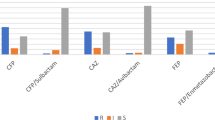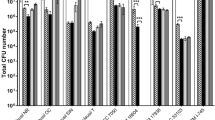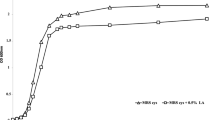Abstract
Drug-induced diarrhea is a common adverse drug reaction, especially the one caused by the widespread use of antibiotics. The reduction of probiotics is one reason for intestinal disorders induced by an oral antibiotic. However, the intrinsic mechanism of drug-induced diarrhea is still unknown. In this study, we used metabolomics methods to explore the effects of the classic oral antibiotic, amoxicillin, on the growth and metabolism of Lactobacillus acidophilus, while scanning electron microscopy (SEM) and 3-(4,5-Dimethylthiazol-2-yl)−2,5-diphenyltetrazolium bromide (MTT) assays were employed to evaluate changes in cell activity and morphology. The results showed that cell viability gradually decreased, while the degree of cell wall rupture increased, with increasing amoxicillin concentrations. A non-targeted metabolomics analysis identified 13 potential biomarkers associated with 9 metabolic pathways. The data showed that arginine and proline metabolism, nicotinate and nicotinamide metabolism, pyrimidine metabolism, glycine, serine and threonine metabolism, beta-alanine metabolism, glycerolipid metabolism, tryptophan metabolism, steroid hormone biosynthesis, and histidine metabolism may be involved in the different effects exerted by amoxicillin on L. acidophilus. This study provides potential targets for screening probiotics regulators and lays a theoretical foundation for the elucidation of their mechanisms.
This is a preview of subscription content, access via your institution
Access options
Subscribe to this journal
Receive 12 print issues and online access
$259.00 per year
only $21.58 per issue
Buy this article
- Purchase on Springer Link
- Instant access to full article PDF
Prices may be subject to local taxes which are calculated during checkout







Similar content being viewed by others
Data availability
The datasets analyzed in this manuscript are not publicly available. Requests to access the datasets should be directed to the corresponding author ZS.
References
Blumenthal KG, Peter JG, Trubiano JA, Phillips EJ. Antibiotic allergy. Lancet. 2019;393:183–98.
Joint Task Force on Practice, American Academy of Allergy, Asthma and I., American College of Allergy, Asthma and I., Joint Council of Allergy, Asthma and I., Drug allergy: An updated practice parameter. Ann Allergy Asthma Immunol. 2010; 105: 259–73.
Holzapfel PWH, Haberer P, Geisen R, Bjorkroth J, Schillinger U. Taxonomy and important features of probiotic microorganisms in food and nutrition. Am J Clin Nutr. 2001;73:365S–373S.
Jang HM, Lee HJ, Jang SE, Han MJ, Kim DH. Evidence for interplay among antibacterial-induced gut microbiota disturbance, neuro-inflammation, and anxiety in mice. Mucosal Immunol. 2018;11:1386–97.
Zhang J, Sun Y, Wang R, Zhang J. Gut microbiota-mediated drug-drug interaction between amoxicillin and aspirin. Sci Rep. 2019;9:16194.
Flores-Kim J, Dobihal GS, Fenton A, Rudner DZ, Bernhardt TG. A switch in surface polymer biogenesis triggers growth-phase-dependent and antibiotic-induced bacteriolysis. Elife. 2019;8:8.
Tulstrup MV, Christensen EG, Carvalho V, Linninge C, Ahrné S, Højberg O et al. Antibiotic treatment affects intestinal permeability and gut microbial composition in Wistar rats dependent on antibiotic class. PLoS One. 2015;10:e0144854.
Chen CC, Lin WC, Kong MS, Shi HN, Walker WA, Lin CY et al. Oral inoculation of probiotics Lactobacillus acidophilus NCFM suppresses tumour growth both in segmental orthotopic colon cancer and extra-intestinal tissue. Br J Nutr. 2012;107:1623–34.
Hashemi A, Villa CR, Comelli EM. Probiotics in early life: A preventative and treatment approach. Food Funct. 2016;7:1752–68.
Bendali F, Kerdouche K, Hamma-Faradji S, Drider D. In vitro and in vivo cholesterol-lowering ability of Lactobacillus pentosus KF923750. Benef Microbes. 2017;8:271–80.
Abedin-Do A, Taherian-Esfahani Z, Ghafouri-Fard S, Ghafouri-Fard S, Motevaseli E. Immunomodulatory effects of Lactobacillus strains: emphasis on their effects on cancer cells. Immunotherapy. 2015;7:1307–29.
Cuperlovic-Culf M, Barnett DA, Culf AS, Chute I. Cell culture metabolomics: Applications and future directions. Drug Disco Today. 2010;15:610–21.
Alonso A, Marsal S, Julia A. Analytical methods in untargeted metabolomics: State of the art in 2015. Front Bioeng Biotechnol. 2015;3:23.
Zhang H, Zheng H, Zhao G, Tang C, Lu S, Cheng B et al. Metabolomic study of corticosterone-induced cytotoxicity in PC12 cells by ultra performance liquid chromatography-quadrupole/time-of-flight mass spectrometry. Mol Biosyst. 2016;12:902–13.
Zhu J, Djukovic D, Deng L, Gu H, Himmati F, Abu Zaid M et al. Targeted serum metabolite profiling and sequential metabolite ratio analysis for colorectal cancer progression monitoring. Anal Bioanal Chem. 2015;407:7857–63.
Bijlsma S, Bobeldijk I, Verheij ER, Ramaker R, Kochhar S, Macdonald IA et al. Large-scale human metabolomics studies: a strategy for data (pre-) processing and validation. Anal Chem. 2006;78:567–74.
Yu M, Jia HM, Zhou C, Yang Y, Sun LL, Zou ZM. Urinary and fecal metabonomics study of the protective effect of Chaihu-Shu-Gan-San on antibiotic-induced gut microbiota dysbiosis in rats. Sci Rep. 2017;7:46551.
Hattangady DS, Singh AK, Muthaiyan A, Jayaswal RK, Gustafson JE, Ulanov AV et al. Genomic, transcriptomic and metabolomic studies of two well-characterized, laboratory-derived vancomycin-intermediate staphylococcus aureus strains derived from the same parent strain. Antibiotics (Basel). 2015;4:76–112.
Liu X, Zheng H, Lu R, Huang H, Zhu H, Yin C et al. Intervening effects of total alkaloids of corydalis saxicola bunting on rats with antibiotic-induced gut microbiota dysbiosis based on 16S rRNA gene sequencing and untargeted metabolomics analyses. Front Microbiol. 2019;10:1151.
Ginsburg I. The role of bacteriolysis in the pathophysiology of inflammation, infection and post-infectious sequelae. Apmis. 2002;110:753–70.
Zhai RG, Rizzi M, Garavaglia S. Nicotinamide/nicotinic acid mononucleotide adenylyltransferase, new insights into an ancient enzyme. Cell Mol Life Sci. 2009;66:2805–18.
Verdin E. NAD(+) in aging, metabolism, and neurodegeneration. Science. 2015;350:1208–13.
Niederdorfer R, Besemer K, Battin TJ, Peter H. Ecological strategies and metabolic trade-offs of complex environmental biofilms. NPJ Biofilms Microbiomes. 2017;3:21.
Koen N, van Breda SV, Loots DT. Elucidating the antimicrobial mechanisms of colistin sulfate on Mycobacterium tuberculosis using metabolomics. Tuberculosis (Edinb). 2018;111:14–9.
Ghosh A, Ando D, Gin J, Runguphan W, Denby C, Wang G et al. (13)C metabolic flux analysis for systematic metabolic engineering of S. cerevisiae for overproduction of fatty acids. Front Bioeng Biotechnol. 2016;4:76.
Roager HM, Licht TR. Microbial tryptophan catabolites in health and disease. Nat Commun. 2018;9:3294.
Magni G, Amici A, Emanuelli M, Raffaelli N, Ruggieri S. Enzymology of NAD+ synthesis. Adv Enzymol Relat Areas Mol Biol. 1999;73:135–82.
van der Goot AT, Nollen EA. Tryptophan metabolism: Entering the field of aging and age-related pathologies. Trends Mol Med. 2013;19:336–44.
Schiffer L, Anderko S, Hobler A, Hannemann F, Kagawa N, Bernhardt R. A recombinant CYP11B1 dependent Escherichia coli biocatalyst for selective cortisol production and optimization towards a preparative scale. Micro Cell Fact. 2015;14:25.
He J, Guo H, Zheng W, Xue Y, Zhao R, Yao W. Heat stress affects fecal microbial and metabolic alterations of primiparous sows during late gestation. J Anim Sci Biotechnol. 2019;10:84.
Culbertson JY, Kreider RB, Greenwood M, Cooke M. Effects of beta-alanine on muscle carnosine and exercise performance: A review of the current literature. Nutrients. 2010;2:75–98.
Acknowledgements
This research was financially supported by the Natural Science Foundation of China, Guangxi Natural Science Foundation, Youth Science Foundation of Guangxi Medical University, the National Training Programs of Innovation and Entrepreneurship for Undergraduates of China, and Guangxi First-class Discipline Project for Pharmaceutical Sciences.
Funding
This research was financially supported by the Natural Science Foundation of China (81603533, 81660681, 81360638, and 81560626), Guangxi Natural Science Foundation (2018GXNSFAA138096), Youth Science Foundation of Guangxi Medical University (GXMUYSF18), the National Training Programs of Innovation and Entrepreneurship for Undergraduates of China (Grant No.201410598010), and Guangxi First-class Discipline Project for Pharmaceutical Sciences (No.GXFCDP-PS-2018).
Author information
Authors and Affiliations
Contributions
Yue Guo, Hui Song, Zhiheng Su, Xi Liu, Huimin Huang, Yating Lu and Xue Ling performed experimental operations and contributed to data collection. Yiyi Mo and Chunli Yin contributed to data analysis. Hongjia Zhu and Hua Zheng contributed to paper writing. Yonghong Liang, Hongwei Guo, and Rigang Lu contributed to the design of the experiments and revised the article. All authors read and approved the final paper.
Corresponding authors
Ethics declarations
Conflict of interest
The authors declare no competing interests.
Additional information
Publisher’s note Springer Nature remains neutral with regard to jurisdictional claims in published maps and institutional affiliations.
Supplementary information
Rights and permissions
About this article
Cite this article
Guo, Y., Liu, X., Huang, H. et al. Metabolic response of Lactobacillus acidophilus exposed to amoxicillin. J Antibiot 75, 268–281 (2022). https://doi.org/10.1038/s41429-022-00518-6
Received:
Revised:
Accepted:
Published:
Issue Date:
DOI: https://doi.org/10.1038/s41429-022-00518-6



